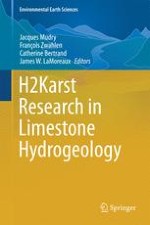2014 | OriginalPaper | Chapter
Using Hybrid Genetic Algorithms in Assembling Master Recession Curves of Karst Springs
Authors : Miloš Gregor, Peter Malík
Published in: H2Karst Research in Limestone Hydrogeology
Publisher: Springer International Publishing
Activate our intelligent search to find suitable subject content or patents.
Select sections of text to find matching patents with Artificial Intelligence. powered by
Select sections of text to find additional relevant content using AI-assisted search. powered by
